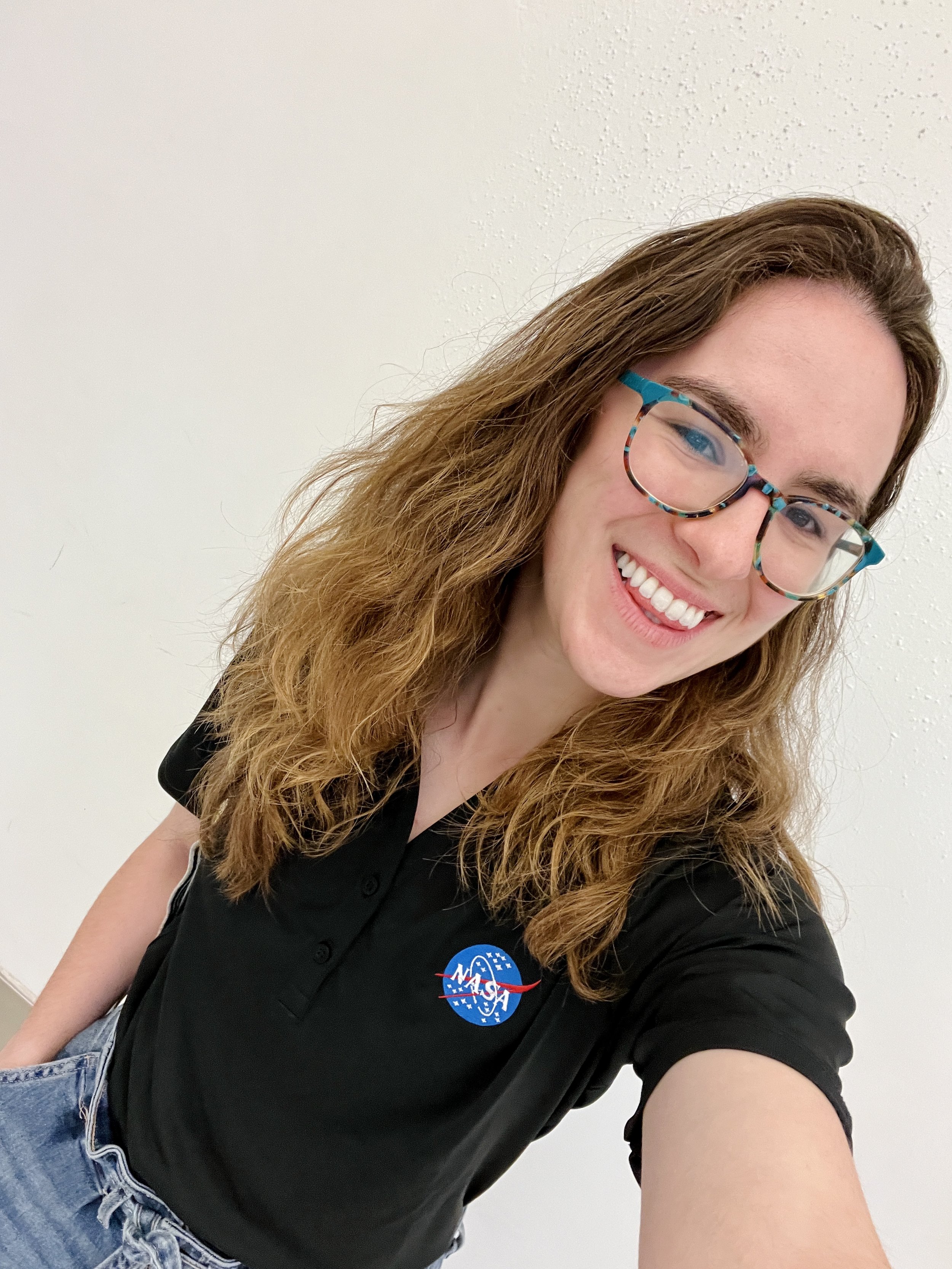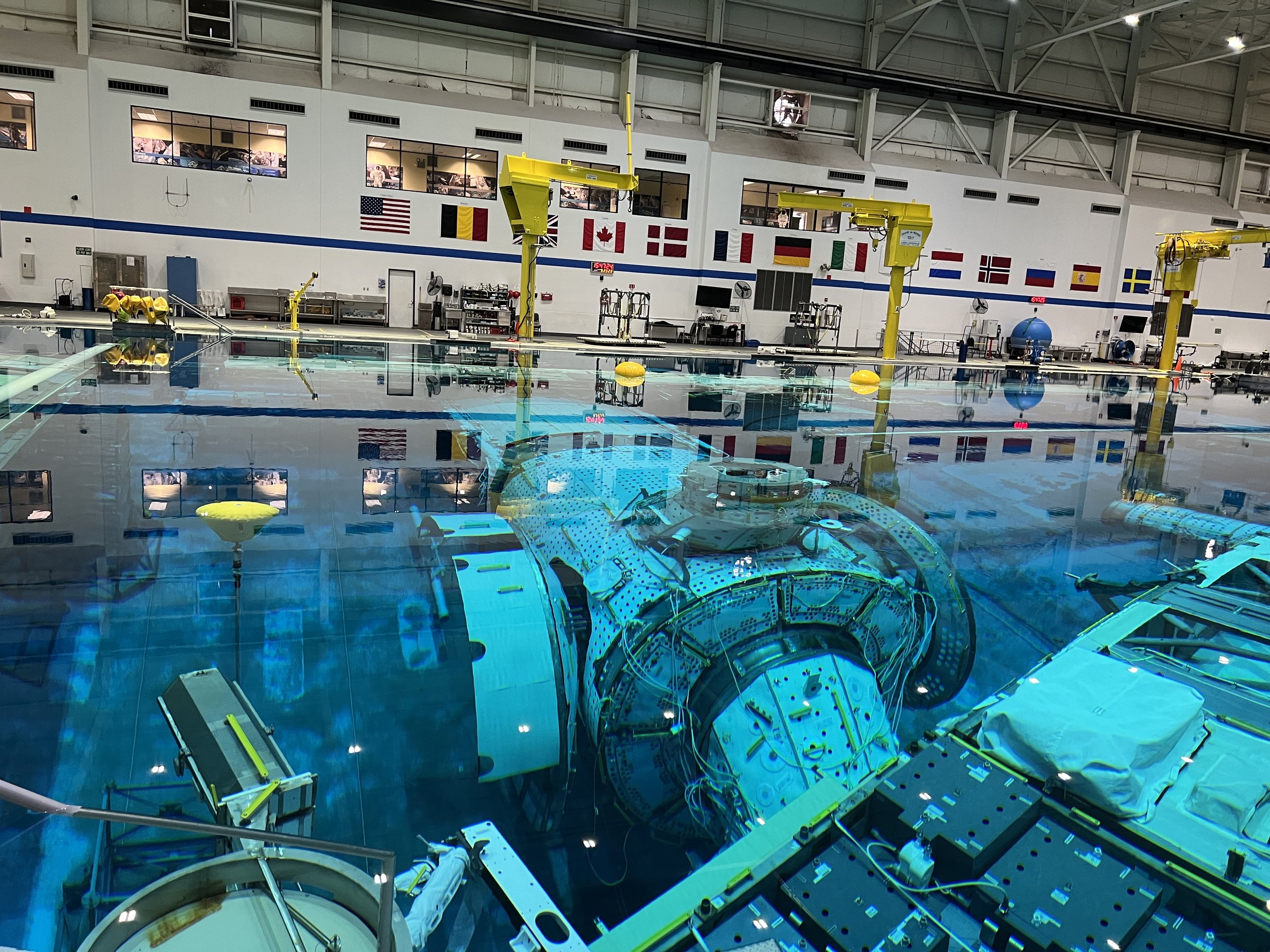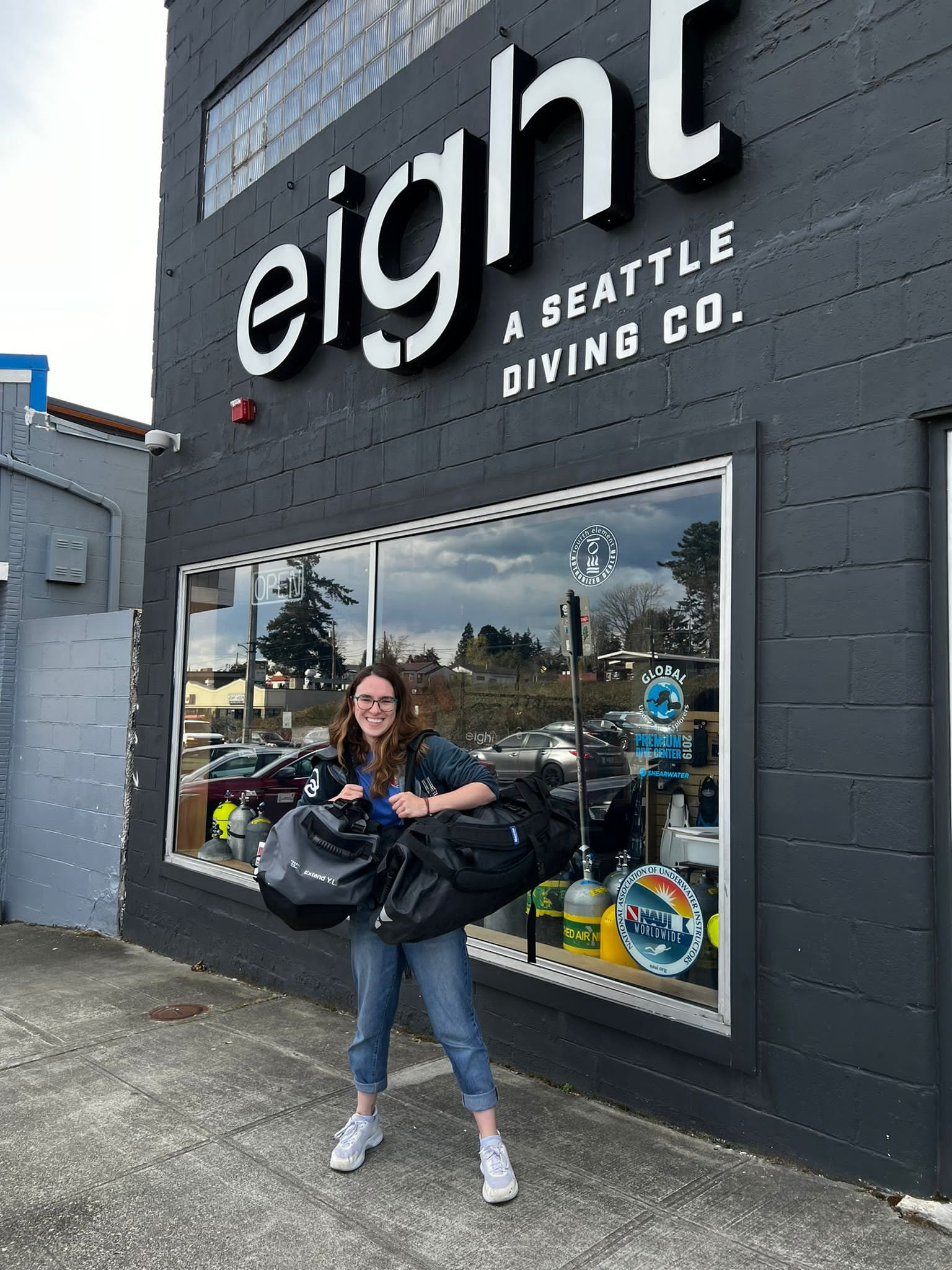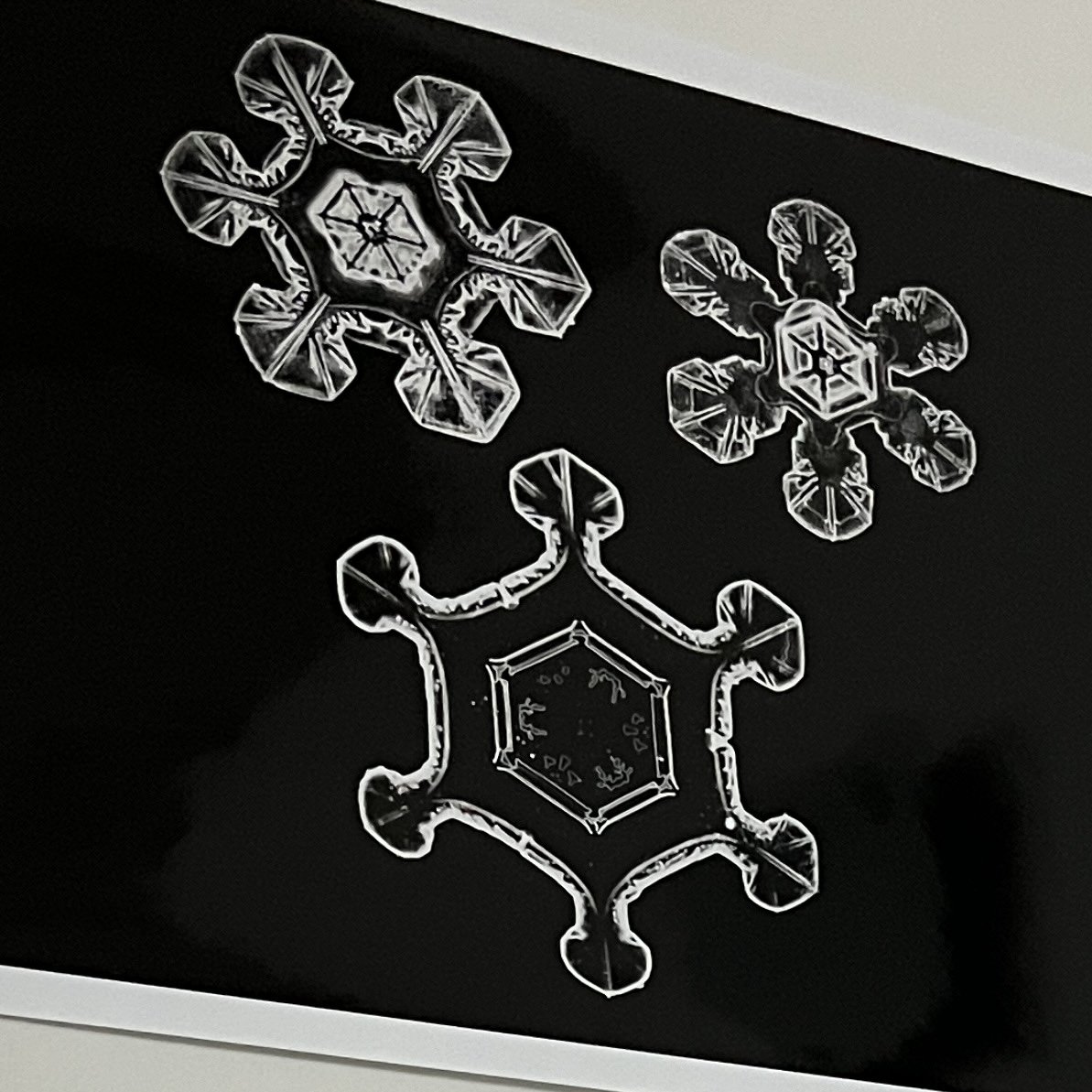April 23 - NextGen Diaries (a dream come true in Houston… and more!)
Part 1 - The continent I was never going to go to
Grab a snack - this is a long read! :) // So, as part of the NextGen scholarship, I was exceedingly grateful to be given a $2000 travel budget, to help me get to the locations I was most passionate about, and to help me cover the logistics when I go to my training courses. Given my location at the time of applying in Saudi Arabia, it was natural that my scholarship mentor was in a GUE Middle-Eastern hub (which is why Dorota is my advisor, and why I was could easily get to Dahab, Dubai and Dibba). In addition, the course that most I wanted to do - Scientific Diver - was taught by European divers. This also worked out well as my initial home base was the UK (so I also had ease of access of travel to the Netherlands, Germany, Italy, etc). These aforementioned places were the locations I had written down for my “top diving destinations” during the scholarship.
Of course, I HAD WANTED to write down places like Antarctica, Polynesia, and New Zealand / California (kelp forests!), but the main priority was the training. I couldn’t justify using the travel budget on flights halfway across the world - when I had amazing instructors on my doorstep, and when I needed to budget hard with my own savings. BUT THEN (like always), serendipity happened at the conference. When I made my introductory speech - I said how I wanted to merge my passions and try and be a diver; not only in expedition vessels, but in neutral buoyancy labs / space research institutions too. Well, the next day, several people told me to seek out Joseph Bosquez - who was the Divesoft ambassador at the conference, but whom used to work for the National Aeronautics and Space Administration’s Neutral Buoyancy Lab (NASA NBL). Long story short: we talked, he put me in touch with his friend Valeria Turcios - an amazing diver who works at the NBL - and she agreed to host me!! WHAT!
Also, Devina Wijaya - @scubadev and a member of the GUE marketing team whom I met at the conference; turned into such a good friend! She (quite a few times) said that I should come to GUE Seattle (her home base) and that we should dive together. My first thought: MONEY AHHH - but I now did have NASA pencilled in. I also initially did have one eye on the Leading Edge 3.0 workshop hosted by Guy Shockey in Vancouver Island. These dates did not quite work out in the end - especially as I was [trying to] conduct survey dives in Dibba at the time (see here!). However, there was nothing really stopping me from going to the USA anyway a week later… Long story short - I may have slashed into my “emergency life savings meant for a future mortgage” - and bought direct flights from Dubai to Houston to Seattle. You only live once, so go for it!
PSA - I always offset my carbon footprint on flights / transport as I am aware of the amount that I am travelling, and the air miles that I am doing.






Part 2 – the NASA NBL
After a 17 hour flight that crossed the North Pole, Valeria picked me up from the airport and we headed into the Sony Carter Training Facility - or better known as the NASA NBL. AND IT WAS MIND-BLOWING. I felt I was living every child’s dream - to see this most amazing playground, and one of the world’s largest indoor pools (of dimensions ~60 x 30 x 12m, and a volume of over 6 million gallons of water). It was such a privilege to be inside! One can feel the gravitas of this building, and its importance to humanity. To walk the same path of all the astronauts who have trained here; to think they have flown in shuttles, worked in the ISS and bounced on the moon - one cannot really put that feeling into words. Humility, pride, extreme imposter syndrome? No seriously; I felt as if I had my “one small step” lunar moment - and I hope one day that it will be for real :P
Ok, now let’s give some context. The NBL’s aim: to provide astronauts with a mock-up of the International Space Station (ISS). Here, they can feel what it would be like to conduct real Extra-Vehicular Activities (EVA’s), and also learn where different modules are on the ISS itself (ie how to traverse across the space station, so it is easier in out-of-world situations). Microgravity is what astronauts experience in space when they float inside the ISS as if they were weightless. On Earth, we cannot mimic the microgravity environment for a long time (the closest comparisons are 30s parabolic flights); thus the NBL is currently the best way to train astronauts, although neutral buoyancy does not equate to microgravity. This is because gravity will still act upon the astronauts underwater, and training in the pool is much harder than on the ISS! Even moving tools underwater are harder due to the drag / weight that each instrument provides in the pool. Indeed, when astronauts come to do actual EVAs, they report how much easier it is to move around in space after conducting NBL training, and how delicate they must now be when carrying heavier objects!
An astronaut training dive is a massive operation which takes 2 dive teams on twinsets; the first group will be in-water for hours 1, 2, 5, and 6, and the second team will jump in for hours 3 and 4. All divers and astronauts are breathing nitrox at EAN46. This is most important for the astronauts themselves, to stop them from going into deco after their long stint in the pool – especially as their spacesuit is pressurised to ~4psi at the surface already (thus exacerbating things at depth!). When the astronauts are craned into the pool, safety divers must make the 300lb spacesuits neutrally buoyant in the water – which will leave the astronaut in a head-up position at a 45-degree angle (the working position on an EVA in the ISS). This requires putting weights and foam on different parts of the body to achieve neutral buoyancy – but the body is still able to hover in the water column at this desired position. This procedure is called the weigh-out - and is individual to each astronaut, or the same astronaut over time!
However, the NBL is also now useful for simulating environments for NASA’s Artemis program – the return to the moon. Putting boots on the lunar surface is part of the Artemis III mission, scheduled for 2025/2026, and so they need to practise! By putting rocks and sand at the bottom of the NBL; and changing the weigh-out to make the astronaut a bit heavier but also “bouncier” – divers can recreate 1/6th gravity environment akin to the moon’s surface. Now with the simulated environment of the moon – astronauts can practise geological sample collection protocols here on Earth, along with the new spacesuits designed for the moon as well. You can now see the rocks and sand in one of the bottom images - which replicates the lunar surface now! So, enjoy the inordinate amount of images of the pool from different angles :D Thanks Val for showing me around!









Photos by me; photo credits of the images of myself go to Valeria / Jim
Over the next days, I again was exceedingly privileged to be given back-stage access to the facilities, to observe astronaut training ops, and personal tours of the Johnson Space Centre space museum / Texas A and M marine buildings at Galveston. The NBL astronaut run we observed was a training dive to manipulate the Space Station Remote Manipulator System (SSRMS) whilst the astronauts were on an EVA. Sometimes, it is more conducive to manipulate an arm to move things or for work as another platform - especially when it would otherwise mean that the astronauts would not be in their usual “EVA position” (or would have to use multiple hands / be in a compromising position / anything that would restrict their movements or increase the risk of letting go). And this all needs practise! Astronaut Matthew Dominik (currently training for his first space deployment ever!) was also being tutored by Michael Barratt, a veteran with over 5 hours of spacewalk time and a specialist on the last Space Shuttle mission. It was an honour to be in the presence of those who have literally been out of this world! After the briefing by the supervisors, it was time for the divers to introduce themselves to their astronaut subjects. Myself, Valeria and Emily (another fabulous NBL diver who was also helping show me around that day!) went over to Matthew for a little briefing / introduction. And then suddenly he unexpectedly turned to me as well. In front of everyone, I ended up introducing myself as well, and explaining that I was no NBL diver but just an observer. He was so friendly, and proceeded to ask all about my scientific / diving experiences, and we also ended up having a 5- minute conservation about sea lions in Monterey Bay. WOW!
When me and Matt stopped talking, it was time to see how the suit was donned, which took a long time! First, Matthew had to wear a cooling suit with water tubes in, and then get into the lower torso (which is quite rigid - the new lunar suits will allow the astronauts to bend at the knees and be more flexible for hiking on the moon). Then, it was the HUT (hard upper torso), and finally the helmet, gloves, and a low-fi (aka lightweight) backpack to simulate their Portable Life Support System. Once lowered into the water from the donning stand, it was time to watch the screens from the pool deck and mission control, see how the divers were faring with the astronaut weigh out today. Once done - it was time to see the simulated EVA in action! It was also great to observe the various functions of the divers: Float Video (video surveillance), Safety (monitoring the astronauts wellbeing) and Utility (help with tool handling and “microgravity assists”). It is important that astronauts do not get used to the effects of gravity when neutrally buoyant, so often when translating or manipulating tools, divers will give them (or their work gear) a little leg-up for even more perceived weightlessness! :) In addition, shout out to Jim for showing me inside the Orion capsule with newly fitted seats for Artemis II!









Photos taken by me / photos of myself taken by Valeria, Emily and Matthew
Part 3 – Dryglove fitting, chasing whales, and scientific photography
I enjoyed my time so much at NASA, and made such meaningful and important connections in just a short time, that we reaaally wanted to stay longer. But, there was no time to process what just happened and the impact of what I had seen on my professional and personal life, as we were again saying goodbye to new friends and boarding a flight - jumping from Houston and arriving in Seattle. GUE Seattle seemed like the most active / vocal / enthusiastic on their facebook groups, and so we were very excited to get to know them more. Devina picked me up in the airport and after the exclamation that I had “BROUGHT SO LITTLE” (for reference, I had a rucksack and 3 giant hold bags haha) - then we were on our way. Driving through the evergreen trees and seeing the snow-covered mountains was (I admit) a truly welcome sight after months and years of deserts and rocks. The cold however, was not welcome. The next day, we drove down to 8Diving, where I was super grateful to be given 8Diving jackets and an exceedingly warm and fluffy GUE Seattle hoody. Meeting Myra from the board was also amazing - she was a star for allowing me to wear her own new drysuit (!!!) along with drygloves, heated vest and fancy undergarments as well. The drysuit fitted well, and so we were all rather impressed!
Some of the days were spent exploring the Pacific Northwest with Devina’s friends too - checking out downtown Seattle, exploring the aquarium / University of Washington and going whale watching (in which we saw 5 grey wales but no orca sadly!) We also we lucky to be given backstage access to probably one of Washington’s best kept secrets - the Intellectual Ventures Laboratory. Here, we saw stunning examples of the latest collaborations between science and photography. For example, there were super-specific auto-tracking camera arrays for time lapses of nebulae, comets and meteorite showers whilst also keeping background galaxies in focus, and robot-manipulated cameras to check videos in situ and take a perfect shot of water flows and object collisions. However, my favourite set up was an amalgamation of dark-field microscopy and sapphire holding slides in a portable dark room connected to a huge camera rig - allowing for the preservation / capture of single snowflakes in extreme environments.












Photos by me; but photo credits of the images of myself go to Devina / Danny
Part 4 - Diving in the PNW with GUE Seattle
And of course, it cannot be a NextGen visit without the diving! On Wednesday night we participated in the weekly Wednesday-at-6pm GUE Seattle meet ups, which hosts both non GUE and GUE divers to come together! This was the first time diving in the sea with a drysuit and doubles, with drygloves, and maybe the 3rd time I dove at sunset. I am a very much a drysuit and double newbie, and I would be lying if I said I wasn’t nervous!! But everyone made me feel so welcome! I admit, in the first 10 minutes I was flapping around like a wounded fish, feeling unstable with the steel twinset, and the restrictions of a poofy undersuit. But once I settled into the dive, it was beautiful to see the soft corals, and the lights of the other divers as they past by us in the dark. And apart from occasionally panicking that the drysuit wasn’t dumping (the hood masked the sound of releasing gas), and having the SPG caught in my too-big drygloves (goodness you lose dexterity!!), the dive was without incident (ie i did not shoot to the surface). I came up to see the night flights glinting on downtown, smiling at the fact that we had done it, but also thinking: “ok I maybe need XL jetfins, medium drygloves, a smaller undersuit, and minus 4lb”. All thanks to my new-found perception of what I need to change in the water. :)
At the weekend, 8Diving hosted a Q and A with me - and apart from thinking “why the heck would they want to do this; I’m not that special” - it was such an great event! In particular, I was so honoured to see that several individuals drove down from Vancouver island, Canada, for this, and how young divers wanted to hear my stories of adventures, exploration and submersibles! And then on the Sunday - we all went diving at Sund Rock - just outside the Olympic National Park - which happened to coincide for my 250th (ish) dive! The GUE Seattle board had booked the entire place out, so it meant a 2h commute with Devina and our dive buddy Kate at 5am, in order to get parked. Luckily, the snow seen on the commute held off! We did 2 beautiful dives entering through the forest (cue me almost dying from the twinset weights); looking for octopus, and I got to marvel at all the DPVs that everyone brought! Maybe I will take a course when I progress. However, it was amazing to see all members of the community come together - from the new to those who have been diving for many decades; hear funny diving stories, and eat lots of post-dive food.












Photos by me and Devina
Over the next few days, myself, Devina, and a few others checked out more dive sites along the coast, and I left myself slowly getting used to my (tight fins!), and making work with what I had. And the tanks did not seem so heavy anymore! As Devina has a lot of followers on insta, we also had fun making content together for GUE Seattle, my GUE vlogs, and for the NextGen Scholarship - applications for which are now open! It was also at this time that my Platinum membership package arrived from HQ, the jacket of which I embroidered with a “NextGen22” name on. Thank you!









Pictures by me / images of myself taken by Devina and George
Part 5 – THANK YOU
I cannot thank Joseph for connecting, and Valeria for literally being my new-found soulmate, and also letting me stay with her for the time I was there. I still cannot believe you took me behind-the-scenes in the coolest place on Earth, and for showing me the life of an NBL diver. I will miss the ocean beach walks, sunset drives, and generally geeking out over all things space and astronaut trainings. I WILL BE BACK SOON. And to all the amazing divers / astronauts I met as well - Alexis, Emily, Claire, Matthew and more! Everyone was so friendly, enthusiastic and amazing individuals who are quite literally changing the world. (And thanks for saying I would fit in there - let’s see if we decide to become a US citizen now). Oh, and shout-out to the lovely women who asked me if I was a YouTuber at Houston airport baggage claim - as she saw me editing my past vlog on the plane here, and really wanted to follow me! After explaining I was no influencer, but did videos for YouTube and GUE, she was excited and still followed the channel (and so shameless plug to do so here as well and like and comment and subscribe to my videos thanks xoxo).
In addition, Seattle is SO GORGEOUS - and I am glad I got to experience some of the PNW in terms of its magical cold water diving and its mountains and hiking. I will be back for sure! I am so grateful for Devina for hosting and organising everything to the T (even when the schedule always had to be updated :P). Her and her family were so welcoming, kind and amazing humans - I have made deep friends for life! See you in November :). Thanks to GUE Seattle and 8Diving for organising the events, to Myra and Danny for the gear (and for also showing me Seattle!!) :D. in addition - those from this amazing community / dive buddies that I met along the way around sites and at Sund Rock - Melissa, Ashley, Bert, Adam, George, Ryan, Doug, Laurie, Chris, Maria etc, including Serey I met at the Q and A. Special shout out to Samuel and Andrea who commuted down from Vancouver island to be at this weekend at meet specifically; you are too kind!! Check out the events, shops and courses of 8Diving and GUE Seattle, as this community was such a pleasure to be a part of, even for just a small time. It is a prime example of the family mentality to diving that GUE envisages to create. They really rolled out the red carpet for me (although I did not deserve it!). Leaving too soon!
For now, it’s back across the pond, and to my “standard GUE scholarship” locations. This time, I am heading closer to home, to spontaneously do a course which first piqued my interest in Deep Dive Dubai, ever since I volunteered as a student with Gemma Thomas in Dubai for a Rec 2 Instructor upgrade (spoilers!). And alongside this - it was now also time to do the course I had always wanted to take with the GUE scholarship…









Pictures by me / images of myself taken by Devina, Danny, Bert, George and Samuel